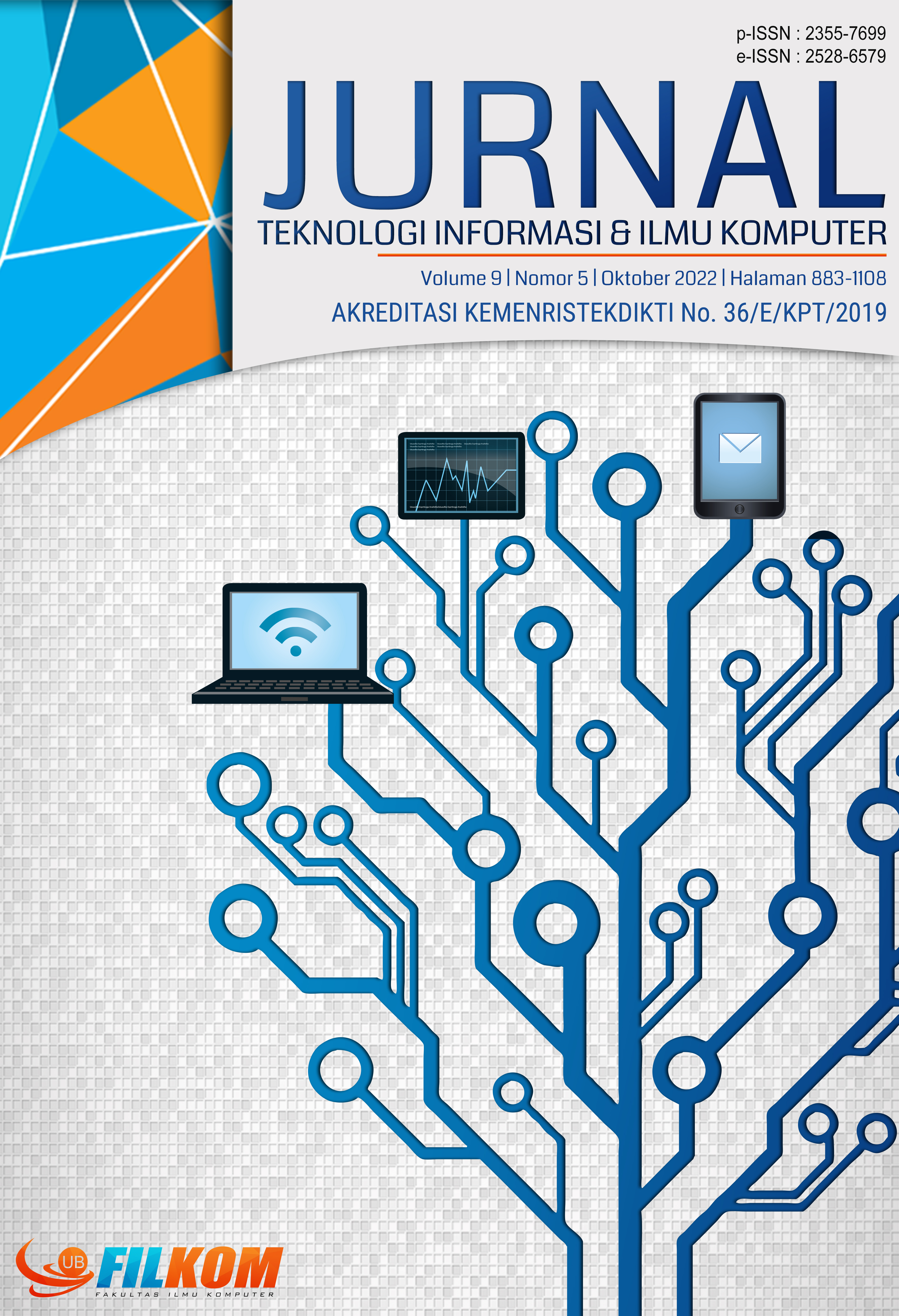Rancang Bangun Aplikasi Mathgeo sebagai Media Pembelajaran Dimensi Tiga Berbasis Mobile
DOI:
https://doi.org/10.25126/jtiik.2021864636Abstrak
Dimensi tiga terdiri atas elemen panjang, lebar dan tinggi yang digunakan untuk menggambarkan bentuk bangun ruang. Namun, kesulitan dalam mendeskripsikan bentuk dapat menjadi kendala bagi siswa dalam memahami materi dimensi tiga. Hal ini disebabkan kemampuan visualisasi siswa yang kurang. Apalagi belum diimbangi dengan pemanfaatan teknologi sebagai media pembelajaran. Dalam mengatasi masalah tersebut diperlukan media pembelajaran digital untuk meningkatkan minat belajar dan pemahaman siswa terhadap materi dimensi tiga. Menggunakan aplikasi ini, pengguna dapat membaca materi, mengerjakan latihan, mengerjakan kuis, dan mengukur pemahaman materi secara mandiri. Aplikasi ini dibangun menggunakan Android Studio dengan metode pengembangan perangkat lunak Waterfall. Pengembangan dimulai dari analisis kebutuhan, perancangan, implementasi dan pengujian. Kebutuhan fungsional diuji menggunakan black-box testing, sedangkan kebutuhan non-fungsional diuji menggunakan compatibility testing dan usability testing. Black-Box Testing menghasilkan validitas 100%. Compatibility testing dilakukan menggunakan fitur Test Lab Firebase, menghasilkan 6 versi android dapat menjalankan aplikasi dengan baik pada versi minimum 7.0 (Nougat) dan versi maksimum 10 (Android Q). Usability testing dilakukan menggunakan metode System Usability Scale (SUS), diperoleh nilai SUS sebesar 87.5. Interpretasi yang diperoleh adalah Grade A+ dengan adjective Best Imagineable dan termasuk dalam kategori dapat diterima.
Abstract
The third dimension consists of length, width and height which are used to describe three-dimensional shapes. However, difficulties in describing three-dimensional shapes can be an obstacle for students in understanding three-dimensional material. This is due to the student’s lack of visualization skills. Moreover, it has not been matched by the use of technology as a learning medium. In overcoming this problem, digital learning media is needed to increase student interest in learning and understanding of three-dimensional material. Using this application, users can read the material, do exercises, take quizzes, and measure understanding of the material independently. This application was built using Android Studio with the Waterfall software development life cycle. Development starts from requirement analysis, design, implementation and testing. Functional requirements are tested using black-box testing, while non-functional requirements are tested using compatibility testing and usability testing. Black-Box Testing yields 100% validity. Compatibility testing is carried out using the Firebase Test Lab feature, resulting in 6 android versions running the application well on a minimum version 7.0 (Nougat) and a maximum version 10 (Android Q). Usability testing was performed using the System Usability Scale (SUS) method, and the SUS value was 87.5. The interpretation obtained is Grade A + with the Adjective Best Imagineable and is included in the acceptable category.
Downloads
Referensi
ALGHADARI, F., HERMAN, T. & PRABAWANTO, S., 2020. Factors AffectingSenior High School Students to Solve Three-Dimensional Geometry Problems. Internasional Electronic Journal of Mathematics Education, 15(3)
ALI, U. & SARMAD, K., 2019. Mobile Application Testing Tools and their Challenges: A Comparative Study. International Conference on Computing, Mathematics and Engineering Technologies.
BASYA, Y. F., 2019. Pengembangan Mobile Apps Android sebagai Media Pembelajaran Matematika berbasis Pendekatan Kontekstual untuk Memfasilitasi Pemahaman Konsep. Jurnal Pengembangan Pembelajaran Matematika, I(1), pp. 1-9.
BHAYSAR, K., SHAH, V. & GOPALAN, S., 2020. Scrumbanfall : An Agile Integration of Scrum and Kanban with Waterfall in Software Engineering. International Journal of Innovative Technology and Exploring Engineering, 9(4), pp. 2075-2084.
EBEL, N., 2019. Mastering Kotlin. Birmingham: Packt.
HILLMAIR, D. et al., 2020. The potential of digital tools to enhance mathematics and science learning in secondary schools: A context-specific meta-analysis. Computers & Education.
IBANEZ, M. B., PORTILLO, A. U., CABADA, R. Z. & LUCIA, M., 2020. Impact of augmented reality technology on academic achievement and motivation of students from public and private Mexican schools. A case study in a middle-school geometry course. Computers & Education, Volume 145.
MULYANI, E. W. S., 2018. Dampak Pemanfaatan Aplikasi Android dalam Pembelajaran Bangun Ruang. Kwangsan Jurnal Teknologi Pendidikan , 06(02), pp. 122-136.
NURYADI, KURNIAWAN, L. & KHOLIFA, I., 2020. Developing Mobile Learning Based on Ethnomathematics Viewed From Adaptive E-Learning: Study of Two Dimensions Geometry on Yogyakarta Palace’s Chariot. International Journal of Education and Learning, 2(1), pp. 32-41.
RAJAGOPAL, D. & THILAKAVALLI, K., 2017. A Study: UML for OOA and OOD. International Journal of Knowledge Content Development & Technology, 7(2), pp. 5-20.
SAHRONIH, S., PURWANTO, A. & SUMANTRI, M. S., 2020. The Effect of Use Interactive Learning Media Environment-based and Learning Motivation in Science Learning Outcomes. International Journal for Educational and Vocational Studies.
SAURO, J., 2011. Measuring Usability with the System Usability Scale (SUS). [Online]
Available at: https://measuringu.com/sus/
[Diakses 15 01 2020].
UMAR, M. A., 2020. Comprehensive study of software testing: Categories, levels, techniques, and types. Preprint powered by IEEE.
Unduhan
Diterbitkan
Terbitan
Bagian
Lisensi

Artikel ini berlisensi Creative Common Attribution-ShareAlike 4.0 International (CC BY-SA 4.0)
Penulis yang menerbitkan di jurnal ini menyetujui ketentuan berikut:
- Penulis menyimpan hak cipta dan memberikan jurnal hak penerbitan pertama naskah secara simultan dengan lisensi di bawah Creative Common Attribution-ShareAlike 4.0 International (CC BY-SA 4.0) yang mengizinkan orang lain untuk berbagi pekerjaan dengan sebuah pernyataan kepenulisan pekerjaan dan penerbitan awal di jurnal ini.
- Penulis bisa memasukkan ke dalam penyusunan kontraktual tambahan terpisah untuk distribusi non ekslusif versi kaya terbitan jurnal (contoh: mempostingnya ke repositori institusional atau menerbitkannya dalam sebuah buku), dengan pengakuan penerbitan awalnya di jurnal ini.
- Penulis diizinkan dan didorong untuk mem-posting karya mereka online (contoh: di repositori institusional atau di website mereka) sebelum dan selama proses penyerahan, karena dapat mengarahkan ke pertukaran produktif, seperti halnya sitiran yang lebih awal dan lebih hebat dari karya yang diterbitkan. (Lihat Efek Akses Terbuka).












